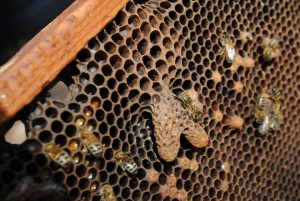Requeening
We had a great talk from Keith Tignor at the monthly ERBA meeting last night. He touched on the fact that there have been very high losses in Virginia this past Winter. The primary reason, based on his findings, was the fact that the bees simply stopped raising brood in the Fall. If this is true, it would definitely be the reason for big losses. I do not recall seeing this and my notes indicate otherwise. But, it would appear that many places suffered a really tough Fall where flowers simply were not producing the pollen and/or nectar that is necessary to maintain brood production in a full hive. I’m not sure if this really was the cause, but it is clearly part of the puzzle. I have only gone through about a third of my hives this month, so I really do not know my casualty count yet, but it doesn’t appear that I have experienced terrible losses. But, I do know of many folks that have.
Another point that Keith made focused on requeening in the Fall. The theory goes that a hive simply has a much higher survival rate if they go into Fall with a brand new queen. I believe that this is likely to be true, in the short term. It only makes sense that a hive with a new queen has a better chance in the immediate future. Whether you requeen ever month, every 3 months, once a year or every other year, the period that follows is likely to be better for your hive. You end up with a queen that is producing fresh pheromones and is likely to be raring to go.
But, I still question this general philosophy and can’t help but wonder if it is not another one of the ‘old practices’ that is hampering today’s beekeepers. By removing your queen just as she approaches 1 year, you are never judging a queen for her longevity. Twenty years go, queens might go 7 years in a hive. Today, you’re lucky if they have enough staying power to last 3. But, I am absolutely certain that some of the queens that are being killed (for requeening) would have made it 4 years. But, those beekeepers will never know, since they kill them before they can prove themselves. It is true that you have to attribute a queen’s longevity to how ‘well’ she was mated. So, one might say that ‘longevity’ has nothing to do with genetics, but is simply based on luck (did she have a good period to mate in, with lots of drones available.) As always, I suggest that there may be another way to look at it.
It is possible that genetics do play a role in how well a queen is mated. One way that Mother Nature may be helping the bees to becoming stronger and better adapted to today’s environment would be queens that have a longer period for when they go out to mate, thus increasing the chances that they are ‘better’ mated then their predecessors. Perhaps they fly longer on a given day or are able to mate more times. There are countless theories that I could provide in this area.
Suffice it to say that I do not requeen in the traditional sense of the word, nor do I believe that it is the right strategy for a sustainable program. I do remove old queens from hives (and let them raise their own), but I never kill them. I will create a Nuc with them and see how they do. Some go on to start a whole new, full-sized hive. Others just become breeder queens. When I have a queen that is coming into her third (and in a very few cases, fourth) year, I’m excited. This is good stuff. The last thing that I want to do is pinch her…

